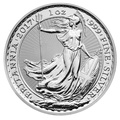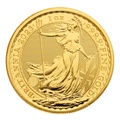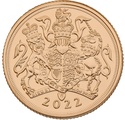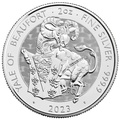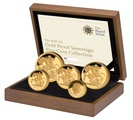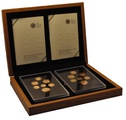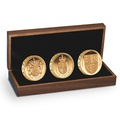Uncirculated coins
When someone talks about uncirculated coins they could mean one of two things. These difference could have a distinct impact on value when referring to bullion coins, so it's important to understand clearly what they mean.
Uncirculated coins could refer to a particular quality of finish in the production process, or whether it has been released publicly for use in shops. The coins we find in our pockets and wallets are circulated coins, used for trade.
Brand new precious metal bullion coins are all technically uncirculated coins therefore, but knowing the difference between the two types mentioned above can make a big impact on the coin you end up with, and the price you pay to acquire one or the money you make from selling one.
What is an uncirculated coin?
For the purpose of this page we will focus on precious metal coins when referring to uncirculated coins. Prior to the First World War, gold and silver coins were minted for public circulation. Small denomination coins like the Shilling and Groat were made of silver, while the Sovereign and Guinea were produced from gold. All of these coins were used regularly across Britain and it's empire.
Since the outbreak of the war, however, gold and silver has been used almost exclusively for uncirculated coins. Coins produced from these precious metals are intended for collectors and investors, and as such they cost much more than their face value.
Even though several UK investment coins are classed as legal tender – such as the Britannia and the Sovereign – they are not circulated as currency that can be spent in day to day shopping and trading. Therefore, for this meaning of the phrase, all modern bullion coins can be considered uncirculated coins.
Brilliant Uncirculated Coins
The other way in which uncirculated is used, in reference to coins, is in the grading system for their quality.
The highest grade of quality is a Proof coin, but just below this is the ‘Brilliant Uncirculated’ grade. These coins are produced to a very high standard using hand-finished dies to ensure a very sharp image. A Brilliant Uncirculated coin is struck twice, speeding up the production time in comparison to the Proof coin, while maintaining a higher quality than a standard bullion coin.
A Brilliant Uncirculated coin is still limited in nature compared to the normal bullion coin, and as such has a higher premium thanks to its semi-numismatic quality. If a dealer states a coin is Brilliant Uncirculated quality then this means it is a more collectable, better condition coin than normal, and will therefore usually have a higher premium above spot price.
Learn more about Brilliant Uncirculated coins and the various quality finishes available in precious metal coins.
Uncirculated coin sets
An uncirculated coin set can refer to either of the two types of coin mentioned above. The Brilliant Uncirculated quality of coin is typically released on its own, but The Royal Mint does occasionally produce ready-made collectible Brilliant Uncirculated coin sets. For example, a four-coin set of Brilliant Uncirculated coins was released for the 50th anniversary of the Queen’s coronation.
The Royal Mint produces a number of other coin sets, ranging from Proof to bullion quality and celebrating key events. These come with varying numbers of coins, of different denominations. As with many other collectible items, having a set of coins with a popular theme is a great way to increase the value of your coins beyond their intrinsic metal value.
- How To Buy Gold
- How to Buy?
- Payment Options
- Delivery Options
- Gold Storage
- Storage at Brink's
- Gold Investment Guide
- Why buy gold?
- Is gold a good investment?
- Why physical gold?
- Best time to buy gold?
- Gold bars vs coins?
- Gold vs Silver
- Gold - Silver Ratio explained
- VAT on bullion
- CGT on bullion
- Legal tender coins
- Top 5 Gold Investments
- Top 5 Silver Investments
- Gold vs ISAs
- Gold vs Buy-to-Let
- Gold vs FTSE 100
- Gold vs Bitcoin
- Where to buy gold?
- Why buy from us?
- Where to sell gold?
- Coin Shops
- Gold Price Forecasts
- Top 10 Gold Producers
- Top 10 Gold Reserves
- Gold Britannia vs Sovereign
- Britannia coin designs
- Sovereign coin designs
- Sovereign Mintages
- Sovereign mint marks
- British coin specs
- What is a proof coin?
- Royal Mint bullion
- The Queen's Beasts
- Royal Mint Lunar Coins
- Bullion Refiners
- British coin mints
- Krugerrands
- Gold Tola - India & Pakistan
- Bullion Index
